#backpackingtips
Explore tagged Tumblr posts
Text

The fairytale-like Uros Islands are made entirely from totora reeds; the lives of the inhabitants of these artificial islands are entirely dependent upon the reed beds they live among.
#cuscojourneys#infomachupicchu#perutreks#incatrail#urosisland#floatingislands#urosislands#puno#islasflotantes#Peru#southamerica#backpackersouthamerica#backpackingtips#titicacalake#titicaca#amantani#sillustani#wanderlust#globetrotter#backpackers#picoftheday#smiling#natgeo#igerspuno#perutravel#discoverperu
7 notes
·
View notes
Text






You’re not packing for survival. You’re packing for memories.
Here’s your no-fluff guide to smart travel packing — what to carry, what to ditch, and how to travel with ease and intention.
👝 Essentials
🎒 Packing hacks
🚫 Things to not pack
🧘 Travel mindset shift
Pack lighter. Travel better.
See you on the edge.
#LipsOnEdge#PackingTips#TravelIndia#SoloTravelIndia#MinimalTravel#SmartPacking#BackpackingTips#WomenOnTheGo#TravelChaosToCalm
0 notes
Text
Lightweight Camping Setup Guide: Essential Gear for Minimalist Outdoor Adventures
Planning the perfect lightweight camping setup requires precision, smart packing, and gear designed for minimalist outdoor adventures. Whether you’re hiking the Rockies, camping in Canadian wilderness, or touring the Lake District in the UK, weight-efficient planning is critical for safety and comfort. This guide breaks down essential items, setup techniques, and expert tips to help you camp…
0 notes
Text
Can a Trekking Tent Handle Harsh Winds and Heavy Rain?

When it comes to outdoor adventures, nothing matters more than shelter. And that’s where the trekking tent steps in. Whether you're a weekend trekker or someone planning a week-long hike into the mountains, choosing the right trekking tent is a decision that can impact your comfort, safety, and overall experience.
But with so many opinions floating around, it’s easy to fall for common myths. So today, we’re busting the top 5 myths about trekking tents that you really need to stop believing.
Myth 1: All Trekking Tents Are Waterproof
This is one of the most common assumptions — and also the riskiest one. Just because a trekking tent is labeled for outdoor use doesn’t mean it can handle a full-blown downpour.
Many tents come with a water-resistant coating, but that’s not the same as being fully waterproof. Over time, exposure to sun, dirt, and even folding can wear off that coating. If you don’t check the seams, zippers, and material regularly, your trekking tent might not keep you dry when it matters the most.
Reality Check: Look for seam-sealed tents and always carry a groundsheet. And if your trekking tent has served you well over a few seasons, it might be time to refresh its waterproof coating.
Myth 2: Lightweight Means Less Durable
It’s easy to think that a light trekking tent might be fragile or not built for tough terrain. But that’s far from the truth. Technology and smart design have changed the game.
Lightweight materials like aluminum poles and high-tenacity fabrics allow modern trekking tents to be both sturdy and easy to carry. Gone are the days when heavy meant strong. In fact, a well-designed lightweight trekking tent can perform just as well, if not better, than a bulkier one.
Reality Check: Weight doesn’t equal weakness. Instead of just looking at weight, check the design, wind rating, and build quality of the trekking tent.
Myth 3: You Only Need a Trekking Tent in the Mountains
Another big myth is that a trekking tent is only for high-altitude adventures. The truth is, a trekking tent is just as useful in forests, deserts, coastal trails, and even your local camping spot.
Its real purpose is portability and protection. Whether you’re hiking for a few hours or days, having a reliable trekking tent gives you freedom. You can stop anywhere, anytime, and sleep comfortably — regardless of the terrain.
Reality Check: If you're on foot and carrying your gear, a trekking tent is your best companion, no matter where you are.
Myth 4: Bigger Tents Are Always Better
Many people think a bigger trekking tent means more comfort. While it’s true that extra space feels nice, there’s a trade-off — weight and pack size. If you’re trekking solo or with one partner, carrying a 4-person tent makes no sense. It adds unnecessary weight and bulk to your backpack.
Also, bigger tents take more time and space to set up. You might struggle to find a flat area on a narrow trail or rocky patch.
Reality Check: Choose your trekking tent size based on how many people will use it and how much weight you're willing to carry. A snug fit often means better insulation too.
Myth 5: All Trekking Tents Are the Same
If you’ve seen one, you’ve seen them all, right? Wrong. Not all trekking tents are built the same. There are single-layer and double-layer tents, freestanding and non-freestanding designs, dome vs tunnel shapes, and options suited for different seasons.
Some are designed specifically for snow, while others are better for summer trails. Just picking any trekking tent without knowing your environment can leave you cold, wet, or uncomfortable.
Reality Check: Understand your trekking route, expected weather, and setup preferences before picking a trekking tent. It really does make a difference.

Final Thoughts
A good trekking tent is like a silent partner on your journey. It won’t talk back, but it will protect you, support you, and let you rest when you need it most. But falling for these myths can lead to bad purchases and even worse experiences out in the wild.
Don’t buy blindly. Do your homework. Understand your needs. A little effort now can make your next adventure safer, lighter, and way more comfortable.
So, the next time someone tells you a common trekking tent myth, smile — because now, you know better.
#TrekkingTent#CampingComfort#TentLife#HikingGear#OutdoorEssentials#BackpackingTips#TentCamping#himmaleh
0 notes
Text
How to Choose the Right Trekking Tent for Any Terrain

When you plan a trek, the scenery, trail, and weather often steal the spotlight. But one thing that quietly plays a huge role in how your adventure goes is your trekking tent. Whether you're hiking through dense forests, rocky mountain trails, or sandy desert paths, your trekking tent becomes your home in the wild.
Choosing the right trekking tent isn't just about color or design—it's about staying dry during a sudden downpour, warm during cold nights, and protected from wind, insects, and unpredictable weather. This blog will guide you through simple steps to help you choose the best trekking tent for any terrain, making your experience safer and more enjoyable.
1. Understand the Terrain You’ll Be Trekking On
The first step to choosing a trekking tent is to understand the type of terrain you're heading into. Not all tents are built for all environments.
Forest Terrain: Go for a trekking tent that has good ventilation and is resistant to moisture and mildew.
Mountain Terrain: You’ll need a wind-resistant and strong-frame trekking tent that can handle snow and harsh cold.
Desert Terrain: Pick a lightweight trekking tent with UV protection and good airflow.
Coastal Terrain: A trekking tent with corrosion-resistant parts and waterproof material is a must.
Each terrain demands different features, so knowing where you're going helps narrow down your options.
2. Consider the Season Rating
Tents come in 3-season, 3-4 season, and 4-season ratings. The higher the rating, the tougher the trekking tent.
A 3-season trekking tent is perfect for spring, summer, and fall. It handles light rain and mild wind well.
A 3-4 season tent can take on heavier rains and colder temperatures.
A 4-season trekking tent is built for winter treks, heavy snow, and strong winds.
Don't over-pack or under-prepare. Match your trekking tent to the expected weather on your route.
3. Weight Matters More Than You Think
When trekking, every gram counts. A lightweight trekking tent can make long hikes easier on your back. But lighter doesn’t always mean better.
Solo trekkers should look for 1-2 kg options.
Groups might need a larger trekking tent, but choose the lightest model that still offers comfort and safety.
Always check the packed weight and consider how much gear you’ll be carrying along with your trekking tent.
4. Space and Capacity
Never choose a trekking tent just based on how many people it says it can hold. A 2-person tent might be fine for one person and their gear, but a tight fit for two.
Ask yourself:
Will you store gear inside?
Do you need space to sit upright?
Are you comfortable with limited elbow room?
Pick a trekking tent that gives you enough space to sleep, change, and rest without feeling cramped.
5. Check for Ventilation
Breathability is important. A trekking tent with poor airflow can get stuffy, especially in humid areas. Look for:
Mesh windows
Cross-ventilation
Roof vents
Good ventilation also helps reduce condensation inside your trekking tent, keeping you dry and comfortable overnight.
6. Waterproofing and Weather Resistance
No matter where you’re going, weather can change. Your trekking tent must be ready.
Look for:
Waterproof floor and rainfly
Taped or sealed seams
Wind-resistant poles and design
Even in dry areas, a sudden downpour can leave you soaked if your trekking tent isn’t built to handle it.
7. Ease of Setup and Takedown
After a long day of trekking, no one wants to struggle with complicated tent poles and confusing instructions. Your trekking tent should be easy to pitch—even in low light or wind.
Choose a model that:
Has color-coded poles or clips
Doesn’t require special tools
Can be set up by one person
Quick setup makes the difference between resting early and wrestling with fabric.
8. Footprint and Floor Protection
Your trekking tent should have a strong base to keep moisture and cold from seeping in. Some come with a “footprint” or groundsheet—an extra layer that protects the tent floor.
If not, consider buying or carrying one separately. It adds minimal weight but saves the base of your trekking tent from tears and wear.
9. Look for Extra Features
Sometimes small additions can add big value:
Storage pockets for gear
A vestibule (small covered area) for muddy shoes
Hooks to hang lights or gear
These might not be must-haves, but they make life inside your trekking tent more organized and cozy.
10. Test Before You Trek
If possible, set up your trekking tent at home before heading out. This gives you:
Practice on setup and takedown
A chance to check for defects
An idea of how much space you’ll really have
Testing also ensures that you pack all the parts correctly, so there are no surprises on the trail.

Final Thoughts
Choosing the right trekking tent isn't about picking the most expensive or the lightest—it’s about finding the one that suits your terrain, weather, and personal comfort.
Think of your trekking tent as your base of safety and peace in the wild. When chosen wisely, it lets you focus on the journey and enjoy nature without stress. So the next time you gear up for an adventure, let your trekking tent be your reliable shelter—no matter where the trail leads.
#TrekkingTent#HikingGear#TentCamping#OutdoorAdventure#BackpackingTips#CampingLife#LightweightTent#himmaleh
0 notes
Text
How I Travelled the World on a Student Budget

Traveling the globe is the stuff dreams are made of—particularly when you're a student who's always scrambling to pay tuition fees, rent, and ramen noodles. And yet, I found myself accomplishing it. No trust fund, no wealthy kin. A little planning, much hustle, and an immense passion to explore the world. It began in my second year of college. I was sitting in my hostel room, going through Instagram, looking at photos of people in Bali, Paris, and Tokyo—and questioning if I would ever get to do that too. I said to myself, "Why not? Let's give it a shot." And that's where it all began. Saving Every Rupee Counts The first thing that I did was to reduce avoidable expenses. I avoided weekend parties, cut down on takeaways, and learned to prepare simple meals. I opened a travel savings account and began to deposit even small amounts of ₹100–₹200 whenever I could. Believe it or not, it comes up! I also began freelancing—writing articles, taking up part-time social media work, and even teaching English online. It wasn't glamorous, but each additional rupee was taking me one step closer to the next place. Selecting Budget Destinations Not all destinations make a hole in your pocket. I chose those nations where the currency was less than the Indian rupee or had low cost of living. Southeast Asia was ideal—Vietnam, Thailand, Indonesia. I even ventured into portions of Eastern Europe such as Georgia and Ukraine, where travel was unexpectedly low-cost. I always went during off-season. Flights were less expensive, hostels offered discounts, and there were fewer people. I also bought tickets well in advance to obtain the most affordable prices. Accommodation Hacks Forget hotels. I slept in hostels, sometimes dorms shared with 10 people. It was fun, social, and affordable. I even had a go at Couchsurfing—sleeping with locals for free. It took a while to get used to, but most of the people I met were friendly, and I got to see local life first hand. Volunteering was also a trick. Working in hostels, farms, and cafes for free accommodation and food through websites such as Work away, I cleaned, assisted with reception, even taught children English for a bed and food. Eating Local, Living Smart Eating like a local was so cost-effective. Rather than expensive restaurants, I dined on street food or bought at local markets and prepared in hostel kitchens. Also, rather than shelling out money for every tourist activity, I discovered free activities—beaches, hiking trails, city walking tours, and cultural festivals. Final Thoughts Traveling on a student budget is not easy—but it's 100% possible. You just have to plan, hustle, and be open-minded. I didn't stay in luxury hotels and dine at fancy restaurants, but I made memories, learned how to be independent, and explored the world with new eyes. If I can do it as a broke student with only a backpack and Wi-Fi, you can too. Dream big, start small—and take that first step.
0 notes
Text
Essential India Travel Tips 2025
Prepare for your trip with essential travel tips for India. Learn how to travel safely, handle transport, and respect local customs from someone who’s been there.
#IndiaTips#TravelTips#VisitIndiaSafely#ExploreIndia#BackpackingTips#IndiaJourney#KnowBeforeYouGo#IndianAdvice#SmartTravel#LocalGuide
1 note
·
View note
Text
A Comprehensive Guide to Backpacking Europe
For cheap and best Travel Bookings - https://tripsdeals.com/
Backpacking across Europe is a dream for many, offering a unique blend of culture, history, and adventure. To make the most of your journey, careful planning is essential. This guide will help you embark on an unforgettable backpacking experience.
1. Plan Your Route
Start by identifying the countries and cities you want to visit. Popular destinations include Paris, Rome, Barcelona, Prague, and Amsterdam. Utilize budget airlines, trains, and buses to move between locations. Websites like https://tripsdeals.com/ can help you find the best travel deals.
2. Budget Smartly
Set a daily budget for accommodation, food, and activities. Hostels, guesthouses, and Airbnb are affordable accommodation options. Save money by cooking your meals or enjoying local street food. Don’t forget to factor in transportation and attraction entry fees.
3. Pack Light
Invest in a high-quality backpack and pack only the essentials. Stick to versatile clothing suitable for various climates, comfortable footwear, and travel-sized toiletries. A universal adapter, portable charger, and a lightweight travel towel are also must-haves.
4. Use Travel Passes
Many European countries offer travel passes for unlimited train or bus rides, such as the Eurail Pass. These passes are cost-effective for long-distance travel and give you flexibility in planning.
5. Stay Connected
A reliable mobile data plan or a local SIM card is invaluable for navigating cities, translating languages, and staying in touch with loved ones. Offline maps and travel apps can save time and reduce stress.
6. Embrace Local Culture
Interact with locals to learn about hidden gems and authentic experiences. Visit free attractions like parks, street art, and historical landmarks. Participate in local festivals or cultural events for a deeper connection to the region.
7. Stay Safe
Always keep your belongings secure, especially in crowded areas. Research local customs and emergency numbers before you arrive. Consider travel insurance to cover unforeseen expenses.
By following these tips, you can enjoy a rewarding and budget-friendly adventure through Europe. Happy backpacking!
#SEO Tags:#BackpackingEurope#TravelGuide#BudgetTravel#TravelTips#EuropeTravel#CheapTravel#AdventureTravel#TripsDeals#BackpackingTips#TravelEurope
0 notes
Text
youtube
#beginnerhikingmistakes#hikingmistakes#beginnerbackpackingmistakes#beginnerhikingtips#hiking#hikingtips#backpackingmistakes#beginnerbackpacking#beginnerbackpackingtips#hikinggear#hikingadvice#backpackingtips#Youtube
0 notes
Text
The Ultimate Guide to Backpacking
For cheap and best Travel Bookings - https://travelinternationals.com/
Backpacking is one of the most thrilling ways to explore the world, offering the freedom to roam, experience diverse cultures, and discover hidden gems that are often missed by typical tourists. Whether you're a seasoned traveler or a first-timer, this ultimate guide to backpacking will equip you with all the essentials to plan a successful journey.
1. Planning Your Backpacking Trip
Before setting off, the most important step is careful planning. Research your destinations thoroughly to understand the local culture, weather, visa requirements, and safety considerations. Choose countries or regions that align with your interests, whether it's hiking in the mountains, exploring ancient ruins, or lounging on tropical beaches.
2. Packing Essentials
When packing for your backpacking trip, light is key. Your backpack should weigh no more than 10–15% of your body weight. Essentials include a comfortable and durable backpack, a sleeping bag, a first-aid kit, a multi-tool, a lightweight stove, and clothes suitable for a variety of climates. Don’t forget to pack travel-sized toiletries and a portable charger to stay connected.
3. Budgeting for Backpacking
Backpacking is often associated with budget travel, and with the right planning, it can be an affordable way to see the world. Consider staying in hostels, guesthouses, or camping to save money. Street food is usually inexpensive and a great way to experience local cuisine. Public transportation is often the most economical option for getting around.
4. Safety and Health
While backpacking can be exhilarating, it's important to stay safe. Always keep your valuables secure and be cautious in unfamiliar areas. Health-wise, make sure you're up to date on vaccinations for your destinations. Carry a basic first-aid kit, and be mindful of local health advice, especially if traveling to remote areas.
5. Sustainability and Responsible Travel
As a backpacker, you’re likely to have a profound impact on the places you visit. It’s crucial to travel responsibly by minimizing your environmental footprint, respecting local customs, and supporting local businesses. Always dispose of waste properly and avoid activities that harm the environment.
Backpacking offers the opportunity to immerse yourself in new cultures, meet fellow travelers, and forge unforgettable memories. With proper planning and an open mind, your backpacking adventure can be the journey of a lifetime.
#Backpacking#TravelGuide#BudgetTravel#BackpackingTips#SustainableTravel#AdventureTravel#TravelEssentials#BackpackingAdventure#SoloTravel#TravelPlanning
0 notes
Text
How to Travel on a Budget: Tips and Tricks
For cheap and best Travel Bookings - https://travelinternationals.com/
Traveling doesn’t have to break the bank. With the right strategies, you can explore new destinations while keeping costs under control. Here are some practical tips and tricks to help you travel on a budget.
1. Plan Ahead and Be Flexible
Booking flights and accommodations well in advance can save you significant money. However, flexibility with your travel dates can also be a game-changer. Use tools like fare comparison websites and apps to find the cheapest days to fly.
2. Travel During Off-Peak Seasons
Peak seasons come with high prices for flights, hotels, and attractions. Opt for shoulder or off-peak seasons to enjoy lower prices and avoid crowds while still experiencing your destination’s charm.
3. Look for Budget Accommodation Options
Consider alternatives to traditional hotels, such as hostels, vacation rentals, or couch-surfing platforms. Many of these options are not only cheaper but also offer a chance to meet locals and fellow travelers.
4. Use Public Transportation
Skip taxis and rental cars whenever possible. Public transportation is often cheaper and gives you an authentic feel for the local culture. Research transit passes that offer unlimited rides for a set period.
5. Save on Food
Avoid dining at expensive tourist hotspots. Instead, try local street food or cook your own meals if your accommodation allows it. Visiting local markets can be both a cultural experience and a budget-friendly way to eat.
6. Take Advantage of Free Attractions
Many cities offer free walking tours, museums, parks, and festivals. Research your destination to find these budget-friendly activities and make the most of them.
7. Travel Light
Packing only essentials can save you money on checked luggage fees. A lighter load also means greater mobility and convenience during your trip.
8. Leverage Travel Rewards
Sign up for airline loyalty programs or credit cards with travel rewards. Accumulating points can significantly reduce the cost of future travel.
By following these tips, you can enjoy memorable adventures without overspending. Remember, the key to budget travel is planning, flexibility, and making informed choices.
#BudgetTravel#TravelTips#AffordableTravel#CheapFlights#TravelOnABudget#MoneySavingTravel#TravelHacks#CheapVacations#BackpackingTips#SaveOnTravel
0 notes
Text
🌍 Dream of Traveling the World on a Budget? 🌍
Yes, it’s possible! With the right tips, you can explore breathtaking destinations without emptying your wallet. Here’s how:
✅ Plan Ahead—but Stay Flexible Find the best deals on flights and accommodations by staying open to dates and destinations.
✅ Choose Budget-Friendly Destinations Discover places like Thailand, Portugal, and Colombia where your money goes further.
✅ Cut Costs on Flights & Accommodation Learn hacks for cheap airfare and affordable stays.
✅ Eat Like a Local Skip the fancy restaurants—street food and local markets are where the magic (and savings) happen!
✅ Embrace Free Activities From hiking trails to cultural festivals, the best things in life really are free.
💼 Want More Tips? Read the full guide on Money Matters to unlock all the secrets to traveling the world without breaking the bank.
➡️ Click here to read more: [https://moneymatters78.blogspot.com/2024/11/how-to-travel-world-on-budget.html]
✈️ Start planning your next adventure today!


#TravelOnABudget#BudgetTravelTips#AffordableTravel#BackpackingTips#TravelHacks#MoneyMattersBlog#ExploreTheWorld#CheapTravelDestinations#SaveMoneyTraveling#WanderlustOnABudget#TravelTipsAndTricks#HowToTravelCheap#GlobeTrotterLife#TravelSmartSaveBig#WorldExploration
1 note
·
View note
Link
❤️ Join this channel to get access to the perks: https://www.youtube.com/channel/UC4SdJPSdwoFhwWkmWZB9wtg/join ❤️ If you find our content helpful, become a channel member to get access to our members-only group, monthly live streams, and more freebies - / @Exploretraveler ▶️ Our YouTube Malaysia Playlist: https://www.youtube.com/channel/UC4SdJPSdwoFhwWkmWZB9wtg 📧 Signup for our Newsletter Email here: https://mailchi.mp/544d66e78709/subscribe-to-exploretraveler 📚 Visit Our Store for gear and travel eBooks: https://www.exploretraveler.shop/ Visit Our Store for free travel eBooks: https://859df3.myshopify.com/ 📚 Support us by buying our eBooks on Amazon: https://www.amazon.com/stores/author/B00WQ75JK6/allbooks?ingress=0&visitId=d447e3d8-5ee4-4c54-a697-92ed7284ec84&ref_=ap_rdr ☕ Support Us By Buying Us A Coffee! https://www.buymeacoffee.com/exploretraveler 💰 Support us with PayPal donations: https://www.paypal.com/paypalme/johngentry1?country.x=US&locale.x=en_US 🌴 View our articles at https://ExploreTraveler.com Briefing Doc: Travel Tips and Insights for Global ExplorersThis briefing doc analyzes key themes and important information from three sources related to travel:
"25 Travel Tips That Can Save Your Life!" by ExploreTraveler.com: This article offers practical advice for staying safe and healthy while traveling, particularly in less-developed countries.
ExploreTraveler Podcast Description: This excerpt highlights the podcast's focus on immersive travel experiences, particularly street food and tips for digital nomads.
"32 Travel Tips That Could Save Your Life" ebook excerpt: This document expands on the article, providing comprehensive advice on travel preparation, hygiene, food/water safety, cultural sensitivity, and first-aid preparedness.
Main Themes:
Preparedness is Key: All three sources emphasize the importance of pre-trip research and planning, including understanding local customs, packing essential items, and learning basic phrases in the local language.
Health and Hygiene: The sources stress the importance of maintaining good hygiene, consuming safe food and water, and being prepared for health issues with a well-stocked first-aid kit and necessary medications.
Cultural Sensitivity: Understanding and respecting local customs is crucial for a positive travel experience. This includes being aware of dining etiquette, appropriate clothing, and hand gestures.
Technology as a Tool: While acknowledging the limitations of technology, the sources recommend utilizing apps for navigation, translation, and staying informed about safety alerts.
Most Important Ideas/Facts:
Toilet Awareness: "Never pass up a good toilet because the next one may be a squat only." (ExploreTraveler.com article) This humorous yet practical tip highlights the importance of being prepared for different bathroom facilities.
Currency Exchange: "Always exchange currency at your destination airport." (ebook) Airports generally offer fair exchange rates compared to local vendors.
Water Safety: "Do not assume the water is clean to drink because locals drink it." (ebook) Locals may have immunities that travelers lack, so bottled or purified water is essential.
Diarrhea Preparedness: "Always carry diarrhea medicine!" (ebook) Changes in diet and exposure to new bacteria can easily lead to digestive issues.
First-Aid Essentials: Both the article and ebook provide detailed lists of essential first-aid items and medications to pack.
Digital Nomad Resources: The podcast description highlights its valuable resources for digital nomads, including visa guides and tips for navigating remote work challenges.
Quotes:
"Being sick, hurt, or excessively tired is no fun but if and when it does happen simple basic information already learned helps you to recover, and to push forward to the future in a controlled, and planed direction." (ExploreTraveler.com article)
"You are only as good as your weakest link. So consider others in your travel party and ensure they stay healthy or you could pay the price later on." (ExploreTraveler.com article)
“Travel and see that the world is full of wonderful people.” - John J Gentry (ebook)
Overall, these sources offer a blend of practical, safety-conscious advice with an emphasis on cultural awareness and utilizing technology effectively. They underscore that while travel can be enriching and transformative, thorough preparation is essential for a smooth and enjoyable journey.
#adventuretravel#backpackingtips#culturalawareness#digitalnomads#exploretraveler#firstaidtravel#globalexplorers#internationaltravel#remoteworktravel#safetravel#traveladvice#travelandtechnology#travelessentials#travelhacks#travelhealth#travelpreparation#travelresources#travelsafety#traveltips#worldtravel
0 notes
Photo

Backpacking Central America Itineraries, Tips and Costs Discover the hidden gems of Central America while backpacking on a budget. Get ready for breathtaking landscapes, vibrant cultures, and unforgettable memories.
0 notes
Photo

Traveling hacks - items to make backpacking easier. Pack like a pro with these genius travel hacks. From space-saving solutions to must-have gear, backpacking has never been easier.
0 notes
Text
Traveling hacks - items to make backpacking easier.

Calling all wanderlusters. Simplify your backpacking journey with these epic travel hacks. Say goodbye to the struggles and hello to hassle-free adventures.
0 notes